Designing a
Rescue Boat for RC Yachts

Eventually I succumbed to a desire to create an
electric powered rescue boat for radio yachts. I started with a set of
design criterion and produced a result which while it doesn't match all
criterion,
certainly performs OK and is definitely worth a look to see how it could be
improved.
Design Criterion
-
Must be a fairly heavy platform with significant
inertia as it will be towing yachts which can weigh up to many Kgms.
It needs to be able to control a large RC yacht despite its likelihood
of having significant sail area.
-
Must be stable as pushing a large RC yacht may
put significant tipping forces on the rescue boat when working from the
side.
-
Must have protection around the propeller.
Any tipping of the rescue boat could result in the propeller gauging the
side of the yacht particularly when driving from the side.
-
Must have sufficient power to deal with the
forces to be encountered in driving a disabled yacht with sails against
wind.
-
Must have a reasonable turn of speed to catch up
with a runaway yacht.
-
Must have a means of capturing the disabled yacht
and remaining hooked onto it.
-
Must protect the disabled yacht from physical
damage.
-
Must be maneuverable ie turn quickly and have
excellent reverse.
-
Maybe required to 'clean' a pond or sailing area
of debris such as reeds, small twigs or even the occasional floating
log.
Hull choice and issues addressed
There are many designs of boats that could be
suitable for a rescue boat. The simplest would be a hard chine power
boat shape. This could satisfy many of the design criterion. I
chose a one metre hull as I had a mold of a 'Triple Crown' and it was easy
to pop out another hull. While easily driven, it lacks stability both
static and at speed. To deal with the static stability the boat hull was
fitted with a short IOM keel of about 10 cms depth and fitted with a 1800g
bulb. To deal with the speed stability, a flat planing surface was
added to the rear of the hull extending a few cms beyond the transom with a
width similar to that of the maximum beam. The keel/bulb addition has
some advantages giving great stability and able to catch reeds and small
sticks or branches but makes it difficult to power through reeds that are
actually growing near the edge of the water which is often where disabled
yachts end up. I figured more power should solve this.
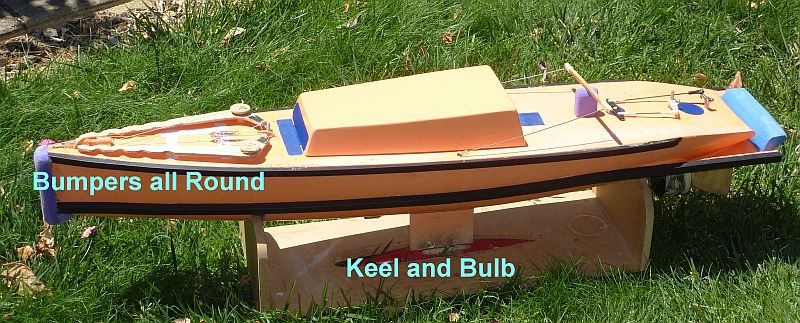
Power Train
To give the rescue boat plenty of power and to trade
top speed off for more thrust, I chose a low revving motor with a large
diameter propeller running at a low voltage to keep the revs down.
Hobby King have many examples of motors to use though many are designed for
max revs rather than max torque at low revs which is more suited to the
rescue boat needs. The particular model I chose was 3660-1460. The propeller I used is 65mm diam. which gives
plenty of thrust. An appropriate speed controller is essential
and should be programmable to ensure it can be made to start quickly, have
forward and reverse. The programmer can make adjustments to increase
reverse power and make forward - reverse changes happen quickly. I
chose the Turnigy Aquastar 120A controller and the appropriate Turnigy
Aquastar programming card. These
items from Hobby King are not cheap but as they are the key to success be prepared to spend
here. I chose to connect the motor and shaft with a double universal
coupling ensuring quiet running without the need to perfectly align them.
The motor is supplied with power from a 3 cell 4500 mAh LiPo battery.
Both the motor and controller have water jackets and I fitted a scoop
beneath the hull to force water through them.
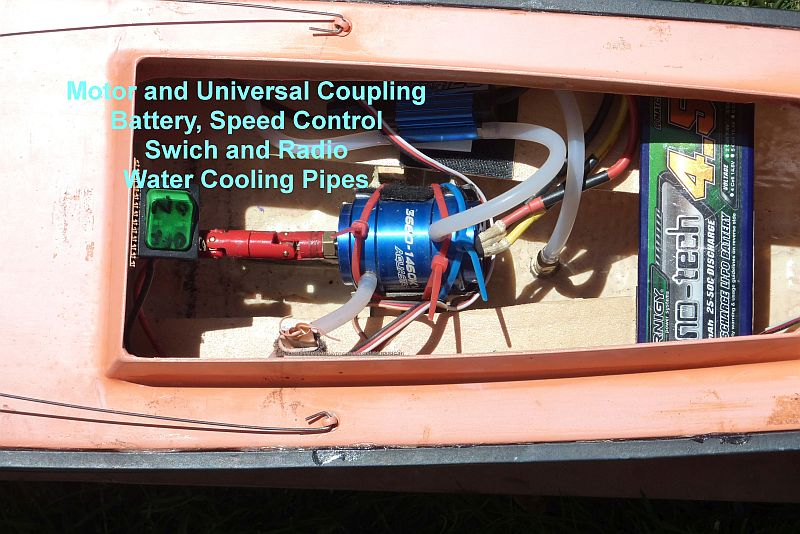
Propeller Protection and steering
To protect the propeller and to enable maximum thrust
while giving good maneuverability I produced a carbon fibre shroud to
surround it. This shroud turns as well as an aft mounted rudder giving
quite good turning with just a single drive train. It would have been
better maybe to have a dual drive system but the cost doubles so I opted for
simplicity. Both thrust and speed have proved more than adequate.
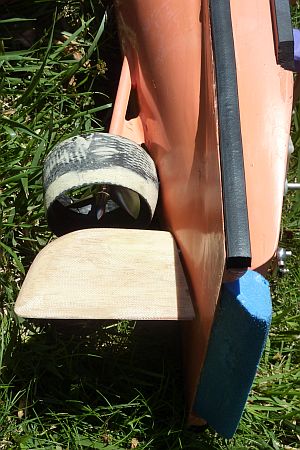
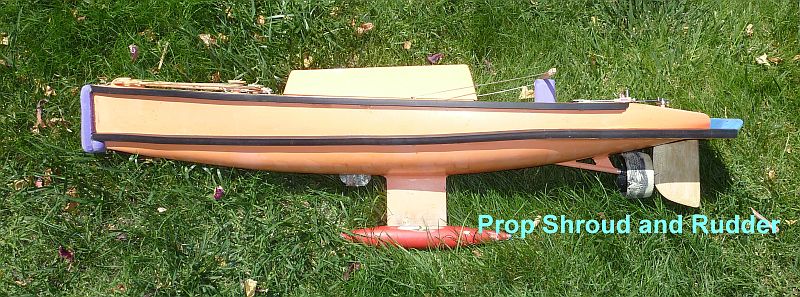
Protection for Rescued yachts
The rescue boat is surrounded by two rubber bumpers.
One on the gunwale region and a second near the water line. A front
bumper on the stem is large and matches the side ones while a rear bumper on
the aft edge of the planing extension completes the protection for RC
yachts. The lower bumper near the water line also acts as and
excellent planing strake by throwing the water out from the hull. The
rear bumper is angle out beyond the planing surface and generates lift when
reversing so keeping the rear of the boat form submarining.

Yacht Catching Arms
Two arms controlled by a simple yacht sail winch open
outwards to a position at right angles to the hull. The arms are
sculptured to catch on a vertical object on the disabled yacht. It
works by hooking on to shrouds, backstay, jib boom swivel, mast, mainsheet
post or main or jib sheets. When disabled a yacht will often have the
rudder off centre so causing it to sail in a circle. Placing the
rescue boat on the inside of the turn can often create enough friction on
the side bumpers to guide the yacht home.
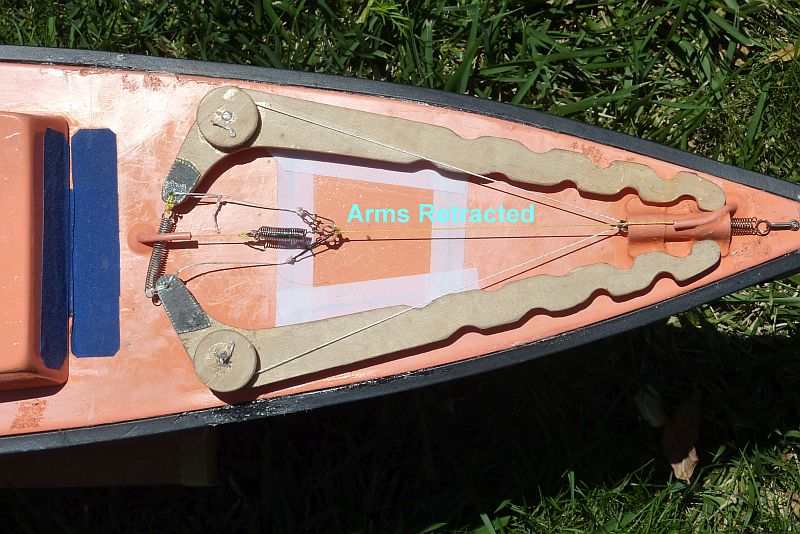
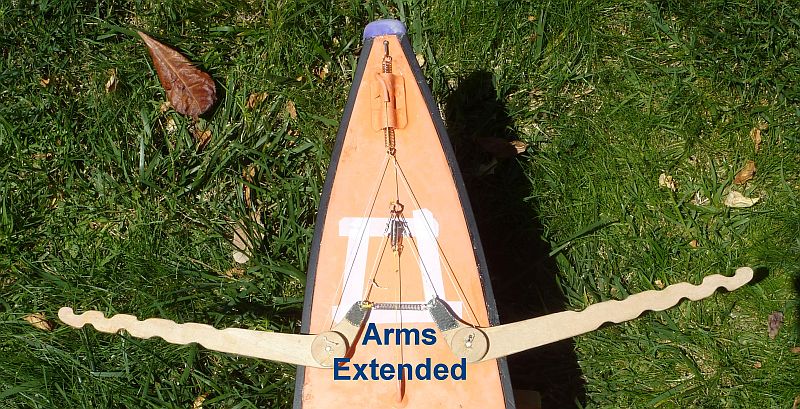
Radio Programming
I use a mode 2 spectrum dx6i because I had one.
The controls though suggest that you could use either a mode 1 or 2 radio effectively.
The throttle action (left knob) is used to control the movement of the
catching arms
while the speed control is governed by the rudder action(side movement of
left knob) This takes a little getting used to but the speed control
needs a self centering action while the arms need an in or out position which
holds. The normal aileron control on the right knob is used to control
the rudder and propeller shroud. (The speed control could have
been set up on the right knob on the elevator control but I found the
interaction between steering and speed a little dangerous as I often added
throttle when steering - up to you). In addition two mixes feeding
to the rudder action (really speed) are set up on two switches to allow a
three position fixed speed. Slow ahead with switch one on, medium ahead with
switch two on and fast with both on. As well the throttle control was
set up with dual rates to allow finer control when making the final approach
to the disabled yacht.

How does it perform
Considering the many possible options that could have
been chosen, I have been more than happy. Power and speed are more
than adequate but occasionally necessary. Maneuverability is good
forward though not so good in reverse. A dual drive system or a side
thruster would be a bonus but more complex. Capturing disabled yachts
with mast up is good to excellent but care has to be taken if attempting a
retrieval of a yacht with the mast down (I have damaged one sail and jammed
up the shaft with a backstay). Retrieval from reeds is problematic -
it depends on how many loose reeds there are in the water. Usually
brute force wins out even with the fin / bulb getting caught. Maybe an
old style keel with sloping front and weight molded onto the bottom would be
better? Picking up reeds, sticks and even floating branches from the
pond are a doddle as the bulb and fin catch most readily. We seldom
need to get our dinghy to rescue yachts and on one occasion when forced to
use a very hard to row flat bottom aluminium dinghy, the rescue boat
adequately pushed it into a twenty knot wind when the rower became tired.
Power
It certainly has more than enough power. It
pushed this dinghy into a 20 knot headwind with no problems!
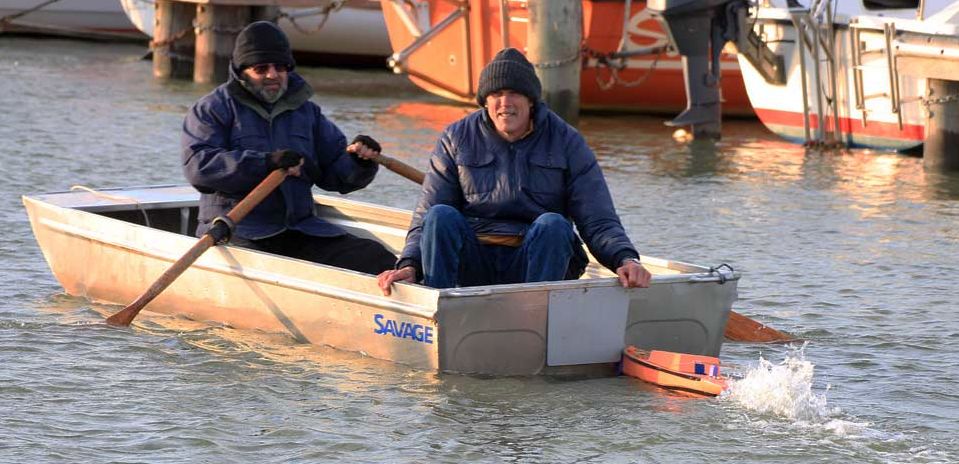
Video
See a short video of the rescue boat in operation on
YouTube at
https://youtu.be/BEQy-AMAo_8
Video Link:
For some time I have tried to add a video link from
the rescue boat to my transmitter with only minimal success. I used a
low powered 2.4 gHz video link which may have suffered from interference
with the 2.4 GHz radio. I found about 40m was the maximum range and
when it approached the reeds, the signal would break up and be useless.
I have subsequently replaced this with a higher
powered 5.8 GHz system and it has been amazingly successful. The
signal no longer breaks up near reeds and the range is much greater
certainly beyond 80m. I am now able to manouver the rescue boat
accurately from a distance and get most yachts out of the tricky reeds
surrounding our lake. The transmitter / camera is mounted on top of
the hatch and the screen and receiver attached to the transmitter. I
shrouded the screen with black corflute to aid visibility.
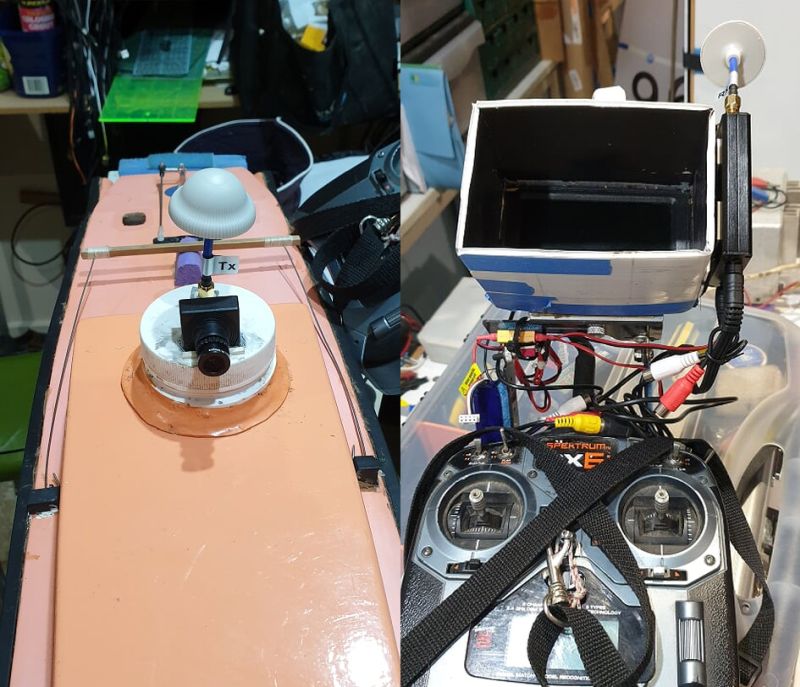
I would love to hear comments and examples of other
rescue boats people have used and will add them to this page
e-mail Ben Morris